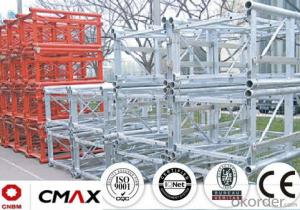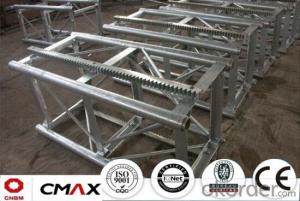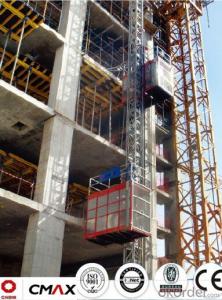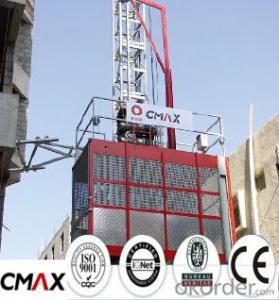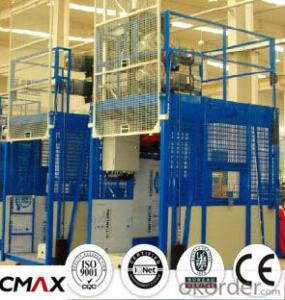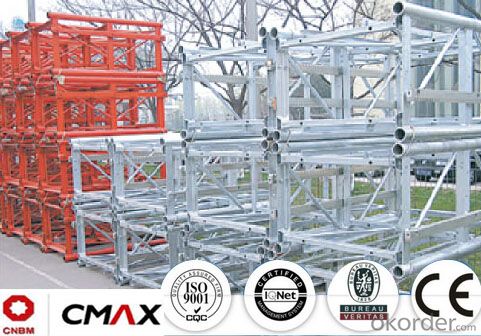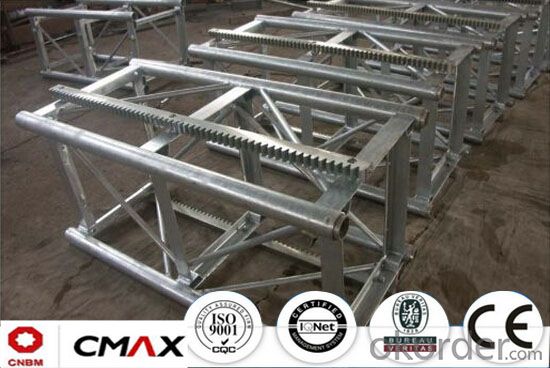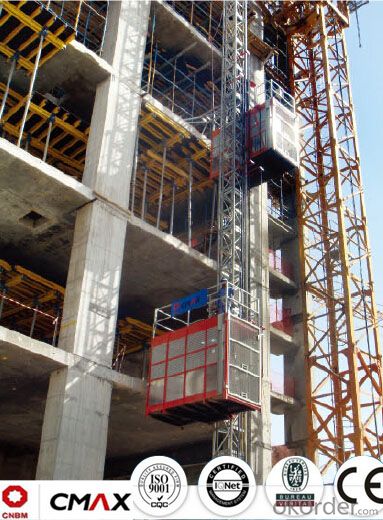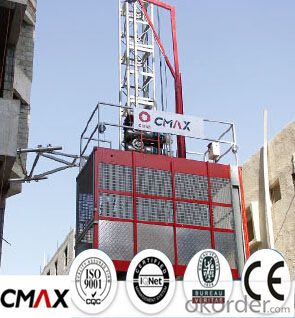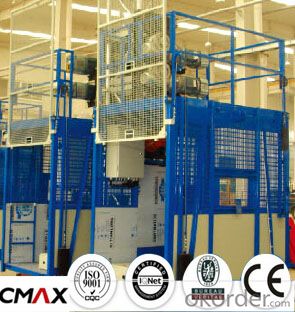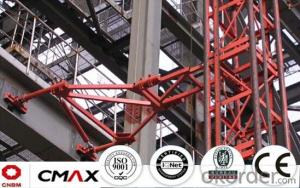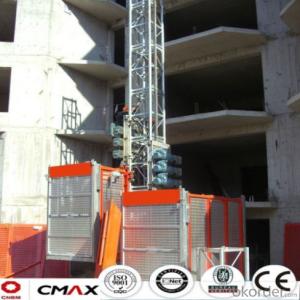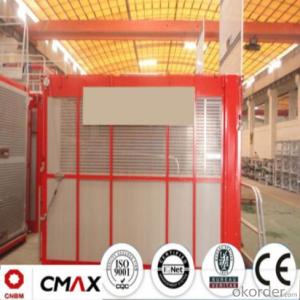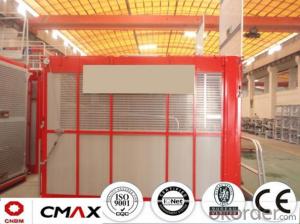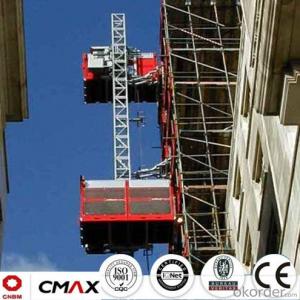Building Hoist Mast Section Manufacturer with Max 4ton Capacity
- Loading Port:
- China main port
- Payment Terms:
- TT OR LC
- Min Order Qty:
- 1 unit
- Supply Capability:
- 10 unit/month
OKorder Service Pledge
OKorder Financial Service
You Might Also Like
Structure of Building Hoist with Max 4tons Capacity Description
The hoist can be widely used in industrial and civilian construction, bridge, under well, big chimney as well as shipping industry to carry people and materials. As permanent or semi-permanent equipment, hoist can be used in different sites such as warehouse, high tower, etc.
With the advantages of reliable performance, safety, easy carrying, high adaptability, it can reduce operators’ work intensity.
With many advanced technology integrity, strict control on each making process, high ratio of price and quality, CMAX hoist has become a symbol of lifter with high quality and excellent after-sales service.
Packaging & Delivery of Building Hoist with Max 4tons Capacity
Packaging: nude and wooded box Delivery: 25-30days
Mains Parts of Building Hoist with Max 4tons Capacity
1.Metal structure including the mast, tie in and cabin ,could be spay-painted and hot galvanized. Mast section is produced with high quality Q345B seamless steel pipe.
2.The electrical system can be adopted with the normal control method and VVVF+PLC control method. Inverter we adopted is from Schneider. Yaskawa and other world famous brand.
3.Electric parts are all equipped with Schneider , Siemens and other top brands.
4.Cabin exit door adopts ramping type. The ramping door likes a bridge between the building hoist and construction building.
Building Hoist with Max 4tons Capacity Images



Building Hoist with Max 4tons Capacity Specification

FAQ of Building Hosit with Max 4ons Capacity Capacity
Q: What is the main structure of building hoist?
A: The P/M construction hoist mainly contains metal structure, driving system, electrical control system, cable guide & protection system, electrical top crane and safety device.
Q: What is the building hoist main purpose?
A: Building hoist equipped with double or single cabin to transport the materials and labors up and down. It's the ideal construction equipment for vertical transportation in the field of construction.
- Q: Safe use of construction elevator
- 1. Construction enterprises must establish and improve the construction lifter of all kinds of management system, the implementation of the professional institutions and management personnel, clear the safe use and management responsibility system at various levels. The driver of the elevator should be trained by the competent department of the relevant administrative department for the training of qualified personnel. The driver should do the routine inspection, namely, when the elevator is first run, each class should be free and full of trial operation. 4. Establish and implement the system of regular inspection and maintenance, each week or each ten-day of elevator to conduct a comprehensive inspection, to find out the hidden dangers in accordance with the "armed" principle to carry out the rectification. After the rectification must be checked and confirmed by the relevant personnel, the safety requirement will be used.
- Q: This question asks whether building hoists can be utilized in limited areas like rooms or tunnels.
- <p>Yes, building hoists can be used in confined spaces such as rooms or tunnels, but it depends on the specific design and size of the hoist. Compact and portable hoists are available for use in tight spaces. However, safety considerations, space dimensions, and the weight capacity of the hoist must be taken into account. It's crucial to ensure that the hoist is suitable for the confined area and that all safety protocols are followed to prevent accidents.</p>
- Q: Is it safe to use a building hoist for lifting heavy objects when there is wind?
- <p>Using a building hoist in windy weather is generally not recommended due to the increased risk of accidents. Wind can cause the hoist to sway, potentially leading to loss of control and dropping of the load. Safety guidelines typically advise against hoisting operations when wind speeds exceed certain limits, often around 20-30 miles per hour (32-48 kilometers per hour). It's crucial to check local regulations and the manufacturer's guidelines for the specific hoist model to determine safe operating conditions. Always prioritize safety and ensure that all necessary precautions are taken to secure the load and the hoist in windy conditions.</p>
- Q: Is it possible for non-professionals to overhaul or repair a hydraulic cylinder in a building hoist?
- <p>No, a hydraulic cylinder in a building hoist should not be overhauled or repaired by non-professionals. Hydraulic systems are complex and require specialized knowledge and skills to service. Attempting repairs without proper training can lead to serious safety hazards, equipment damage, and potential accidents. It is crucial to have a qualified technician or professional mechanic handle any maintenance or repairs to ensure safety and compliance with industry standards.</p>
- Q: This question asks for the cost associated with purchasing and installing a building hoist.
- <p>The cost of buying and installing a building hoist can vary significantly depending on several factors. The type and capacity of the hoist, the height of the building, and the complexity of the installation are key determinants. On average, the cost can range from $10,000 to $50,000 for the hoist itself, with installation costs potentially adding another 20-50% to the total. However, for very tall buildings or specialized hoists, the price can exceed $100,000. It's crucial to obtain quotes from multiple suppliers and installers to get an accurate estimate for your specific project.</p>
- Q: Is it possible to use a building hoist for lifting light objects without any additional tools?
- <p>Yes, a building hoist can be used for lifting light objects without using any tools. Building hoists are designed to lift a variety of materials, including lighter items, within their weight capacity. However, it's crucial to ensure that the hoist is rated for the weight of the object and that safety protocols are followed to prevent accidents. Always consult the hoist's manual for specific guidelines on weight limits and safe operation procedures.</p>
- Q: Can a building hoist experience technical issues or fail to operate properly?
- <p>Yes, a building hoist can malfunction. Like any mechanical system, hoists are subject to wear and tear, component failure, and can be affected by human error. Malfunctions may include mechanical breakdowns, electrical faults, or safety device failures. Regular maintenance, inspection, and adherence to safety protocols can reduce the risk of hoist malfunctions.</p>
- Q: What are the essential maintenance tasks and checks required to keep a hydraulic building hoist in good working condition?
- <p>Regular maintenance of a hydraulic building hoist is crucial for safety and efficiency. Key requirements include inspecting and lubricating moving parts, checking for leaks in hydraulic lines and seals, ensuring the hoist's load limit is not exceeded, and verifying the operation of safety devices like limit switches and emergency stops. Additionally, the hydraulic fluid should be checked for contamination and changed as needed, typically every 1000 hours of operation or annually. The electrical system should be inspected for any damage or wear, and all controls should be tested for proper functionality. A thorough inspection by a qualified technician is recommended at least once a year to ensure all components are in compliance with safety standards.</p>
- Q: This question asks for criteria to differentiate between electric and hydraulic building hoists for selection based on specific needs.
- <p>When choosing between electric and hydraulic building hoists, consider the following: 1) Power Source: Electric hoists require a reliable electricity supply while hydraulic hoists need a power source for the hydraulic pump. 2) Lifting Capacity: Electric hoists often have higher lifting capacities. 3) Speed: Electric hoists generally offer faster lifting and lowering speeds. 4) Maintenance: Hydraulic hoists may require more frequent maintenance due to fluid changes and potential leaks. 5) Noise: Electric hoists are quieter. 6) Cost: Initial costs and operating expenses should be compared. 7) Safety: Both types have safety features, but electric hoists might offer more advanced safety options. 8) Environmental Factors: Consider weather conditions; electric hoists are less affected by rain and cold. Your choice should align with the project's specific requirements, such as the weight of materials to be lifted, frequency of use, and environmental conditions.</p>
- Q: This question asks for guidance on selecting the appropriate lifting equipment based on specific requirements.
- <p>Choosing the right type of lifting equipment involves assessing several factors: the weight and size of the load, the environment in which the lifting will occur, and the specific tasks to be performed. Consider the load capacity required and ensure the equipment can handle the heaviest item you need to lift. Evaluate the space constraints and accessibility of the lifting area. Select equipment that is safe for the environment, such as explosion-proof models for hazardous areas. Consider the need for mobility and whether the equipment should be portable or fixed. Finally, consult with equipment manufacturers or industry experts to ensure you choose equipment that meets all safety standards and is suitable for your specific lifting needs.</p>
Send your message to us
Building Hoist Mast Section Manufacturer with Max 4ton Capacity
- Loading Port:
- China main port
- Payment Terms:
- TT OR LC
- Min Order Qty:
- 1 unit
- Supply Capability:
- 10 unit/month
OKorder Service Pledge
OKorder Financial Service
Similar products
Hot products
Hot Searches
Related keywords
